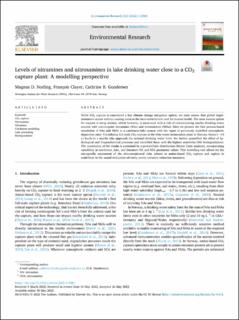| dc.contributor.author | Norling, Magnus Dahler | |
| dc.contributor.author | Clayer, Francois | |
| dc.contributor.author | Gundersen, Cathrine Brecke | |
| dc.date.accessioned | 2022-07-13T12:42:12Z | |
| dc.date.available | 2022-07-13T12:42:12Z | |
| dc.date.created | 2022-06-03T12:24:40Z | |
| dc.date.issued | 2022 | |
| dc.identifier.citation | Environmental Research. 2022, Volume 212, Part D, 113581. | en_US |
| dc.identifier.issn | 0013-9351 | |
| dc.identifier.uri | https://hdl.handle.net/11250/3005068 | |
| dc.description.abstract | While CO2 capture is considered a key climate change mitigation option, we must ensure that global implementation occurs without causing harm to the local environment and the human health. The most mature option for capture is using amines, which however, is associated with a risk of contaminating nearby drinking water sources with carcinogenic nitramines (NAs) and nitrosamines (NSAs). Here we present the first process-based simulation of NAs and NSAs in a catchment-lake system with the input of previously modelled atmospheric deposition rates. Considering full-scale CO2 capture at the Oslo waste incineration plant in Norway, future (∼10 y) levels in a nearby lake approach the national drinking water limit. We further quantified the effect of hydrological and biogeochemical processes and identified those with the highest sensitivity (NA biodegradation). The uncertainty of the results is presented by a probabilistic distribution (Monte Carlo analysis), incorporating variability in catchment, lake, and literature NA and NSA parameter values. This modelling tool allows for the site-specific assessment of the abovementioned risks related to amine-based CO2 capture and aspires to contribute to the sound evaluation of costly amine emission reduction measures. | en_US |
| dc.description.abstract | | en_US |
| dc.language.iso | eng | en_US |
| dc.publisher | Elsevier | en_US |
| dc.rights | Navngivelse 4.0 Internasjonal | * |
| dc.rights.uri | http://creativecommons.org/licenses/by/4.0/deed.no | * |
| dc.title | Levels of nitramines and nitrosamines in lake drinking water close to a CO2 capture plant: A modelling perspective | en_US |
| dc.type | Peer reviewed | en_US |
| dc.type | Journal article | en_US |
| dc.description.version | publishedVersion | en_US |
| dc.rights.holder | © 2022 The Authors | en_US |
| dc.source.pagenumber | 7 | en_US |
| dc.source.volume | Volume 212, Part D | en_US |
| dc.source.journal | Environmental Research | en_US |
| dc.identifier.doi | 10.1016/j.envres.2022.113581 | |
| dc.identifier.cristin | 2029342 | |
| cristin.ispublished | true | |
| cristin.fulltext | original | |
| cristin.qualitycode | 2 | |

